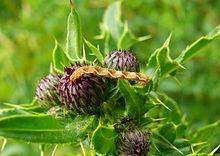Goldenrod moth
| Goldenrod moth | ||||||||||||
|---|---|---|---|---|---|---|---|---|---|---|---|---|

Goldenrod moth ( Eupithecia virgaureata ) |
||||||||||||
| Systematics | ||||||||||||
|
||||||||||||
| Scientific name | ||||||||||||
| Eupithecia virgaureata | ||||||||||||
| Doubleday , 1861 |
The goldenrod moth ( Eupithecia virgaureata ) is a butterfly ( moth ) from the family of the flyers (Geometridae).
features
butterfly
The goldenrod moth is an inconspicuous, but quite common species. Once flown, the species can easily be confused with a number of similar species. The male's antennae for a longer period of time can be an aid to determination.
Caterpillar
The slender caterpillar is yellowish, brownish or greenish in color and has reddish brown or dark green angular markings and side spots of the same color.
Flight time
The goldenrod moth forms two distinct generations per year. These fly from early April to late June and from mid-July to early September.
habitat
Because of the different way of life of the two generations, the goldenrod moth is dependent on different habitat structures. The caterpillars are polyphagous and use dry, sometimes rudder-like locations, but also damp areas on the edge of floodplain and swamp forests . The presence of ragwort and goldenrod species plays an important role . The goldenrod moth also colonizes Calluna heather. For the first generation caterpillars, bushes and hedges are of great importance. The species is not very specialized and has already found its way into gardens. It is therefore a cultural successor that benefits from the rapid spread of the Canadian goldenrod ( Solidago canadensis ) and the giant goldenrod ( Solidago gigantea ), among other things .
Way of life
The caterpillars show different behavior depending on the generation. The caterpillars of the first generation feed mainly on leaves of deciduous trees, while the second generation can be found mainly on the flowers of Solidago and Senecio species.
The caterpillar forage plants include:
- Daylight carnation ( Silene dioicam )
- Common clematis ( Clematis vitalba )
- Common hawthorn ( Crataegus monogyna )
- Purgier buckthorn ( Rhamnus cathartica )
- Little Bibernelle ( Pimpinella saxifraga )
- Parsnip ( Pastinaca sativa )
- Meadow chervil ( Anthriscus sylvestris )
- Forest angelica ( Angelica sylvestris )
- Meadow hogweed ( Heracleum sphondylium )
- Common heather ( Calluna vulgaris )
- Tansy phacelia ( Phacelia tanacetifolia )
- Wasserdost ( Eupatorium cannabinum )
- Common goldenrod ( Solidago virgaurea )
- Giant goldenrod ( Solidago gigantea )
- Canadian goldenrod ( Solidago canadensis )
- Fox's ragwort ( Senecio fuchsii )
- Jacob's ragwort ( Senecio jacobaea )
- Rocket-leaf ragwort ( Senecio erucifolius )
- Fine jet ( Erigeron annuus )
- Common yarrow ( Achillea millefolium )
- Mugwort ( Artemisia vulgaris )
- Marsh thistle ( Cirsium palustre )
- Common bitter herb ( Picris hieracioides )
The brownish to black coloration of the caterpillars is similar to that of withered parts of the plant and serves as camouflage. The moths are crepuscular and nocturnal.
distribution
The species is distributed from the Iberian Peninsula across Western and Central Europe including the British Isles in the temperate zone to Japan . The goldenrod moth is the most common species of the genus in Lapland . The southern area boundary runs through the northern Mediterranean area.
swell
Individual evidence
- ↑ Walter Forster , Theodor A. Wohlfahrt : The butterflies of Central Europe. Volume 5: Spanner. (Geometridae). Franckh'sche Verlagshandlung, Stuttgart 1981, ISBN 3-440-04951-5 .
- ↑ Manfred Koch , Wolfgang Heinicke, Bernd Müller: We determine butterflies. Volume 4: Spanner. 2nd, improved and enlarged edition. Neumann, Leipzig / Radebeul 1976, DNB 780451570 .
- ^ A b Günter Ebert (Hrsg.): The butterflies of Baden-Württemberg Volume 9 (Spanner (Geometridae) 2nd part), Nachtfalter VII. Ulmer Verlag Stuttgart 2003. ISBN 3-800-13279-6
literature
- Vladimir Mironov: Larentiinae II. (Perizomini and Eupitheciini). In A. Hausmann (Ed.): The Geometrid Moths of Europe 4. Apollo Books, Stenstrup 2004, ISBN 8-788-75740-4
Web links
- www.lepiforum.de
- www.kolumbus.fi caterpillar
- Guide to the moths of Great Britain and Ireland
- Eupithecia virgaureata at Fauna Europaea

